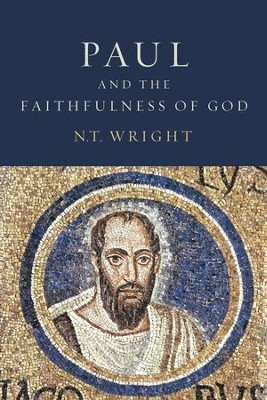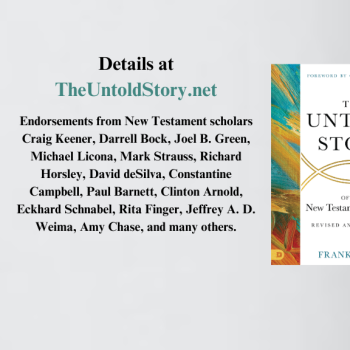N.T. Wright has come out with a new book.
That’s like saying, “Bill O’Reilly just said something controversial.”
The response: “Tell me something new.”
Ah, but this N.T. Wright book is (cough) 1,600 pages long and it appears in 2 volumes.

So how does one write a review for a 1,600 page book?
I’m not sure. You tell me if I pulled it off successfully or not. But I don’t think I can do the book justice.
As I pointed out in my recent interview with N.T. Wright, I believe Wright is the new F.F. Bruce.
I won’t support that statement here as I’ve done so sufficiently in that interview. But Wright’s recent contribution underscores it.
In some respects, N.T. Wright is also the new C.S. Lewis . . . minus Lewis’ amazing gift for writing classic fiction.
Wright’s newest contribution, Paul and the Faithfulness of God, is a two-volume tome that can stop a freight train.
What Wright does so well is recontextualize the New Testament in terms of the cultural setting and mindset of that era. Something I have often done in my own work, though at a popular level.
The fact is, the New Testament was written 2,000 years ago. So reading a document from that era requires that we walk back into a world we don’t understand and get hold of the sociological and cultural context, the original meaning of words and phrases, and the history that led up to the writing of the documents.
If not, we are ripe to make the grave mistake of reading our present-day mindsets and paradigms back into the New Testament.
We do this with our brand of 21st-century “church” all the time when we pick up the Bible. (See Pagan Christianity for how this plays out.)
For Wright, the real Palestinian Paul of Tarsus has been usurped by millennia of religious ideas, many of which have few points of contact with the first century.
Wright takes the classic “Paul a slave-apostle of Jesus the Savior dying on the cross to save ungodly sinners by repenting from their unrighteousness” and reworks it into “Paul the Palestinian yet Greco-Roman-immersed Jew who is faithful to the Messiah’s embodiment of YHWH’s covenant faithfulness.”
Because the book is so dense, it’s often repetitive and states things with long sentences that (I feel) could be reduced in length to make the same points.
I think Tom Wright could have made the same case at half the length. But this isn’t a work for the average reader. It’s a work for the academic community, primarily. However, readers of dense material can profit from it. Those who live on a steady diet of Max Lucado, Francine Rivers, and Beth Moore can use the book as a door stop or a nice fire-starter.
N.T. Wright holds to a grand narrative of Scripture (as do I, as set forth in From Eternity to Here).
On Wright’s scheme, one critical reviewer remarked, “Wright seeks a macro-conceptual/theological narrative through which to read the entire NT. To my mind the risks in this include imposing such a narrative monolithically upon texts.”
This is true. The fact that Wright’s grand narrative is somewhat different from mine is an example of this.
The Missing Ingredient in Wright’s Book – The Eternal Purpose
As my readers know, I believe the grand narrative is what Paul referred to as God’s “eternal purpose.”
The eternal purpose isn’t personal salvation. Nor is it making the world a better place.
So it’s not redemption nor reconciliation.
The purpose of God predated the Fall and wasn’t influenced by the Fall.
How do we know this? Simple. When God created humans, He didn’t create them in need of being saved, reconciled, or redeemed. And when He created the heavens and the earth, neither needed to be liberated and restored because the corruption of the Fall had not yet entered in.
So clearly, God had a purpose — an eternal purpose — that existed beyond the reaches of the Fall. God created humans for something else in mind than being reconciled and redeemed. And He created the earth for something else other than to be liberated and restored. Because neither humans nor the world needed to be reconciled and/or restored in Genesis 1 and 2.
So the classic paradigm of “creation – fall – redemption – restoration” doesn’t follow the narrative of Scripture. We get this from D.L. Moody as I’ve pointed out elsewhere, where everything is about the salvation of souls and the transformation of the world.
Instead, the biblical paradigm is “eternal purpose – creation – fall – redemption – eternal purpose.”
And God’s eternal purpose goes way beyond the reaches of and is far more exciting than “glorifying God and enjoying Him forever.”
Even that statement is a strongly individualistic proposal, something that isn’t exactly in line with God’s magnificent, ultimate, and eternal intention.
(If you want an introduction to what I mean by “God’s eternal purpose,” click here.)
Like most Evangelicals and Reformed thinkers, Wright’s grand narrative still operates on the basis of restoring fallen humanity and restoring a fallen world. Interestingly, though, his emphasis on societal transformation (which is certainly biblical) almost eclipses the many statements in the New Testament (from the Gospels to the book of Revelation) that Jesus came to save sinners and give them eternal life by a bloody death on the cross.
Indeed, we’ve had this aspect of the gospel hammered away by Reformers and Evangelicals alike to the exclusion of other important aspects of the gospel (e.g., the Lordship of Christ, the eternal purpose of God, living by the indwelling life of Christ, etc.).
But one can’t escape the fact that salvation from the penalty of sin is in fact a dominating part of the gospel message according to Paul.
Yes, this element is found in Wright’s work, but it’s not dominant. And sometimes it’s hard to find.
The volume contains a good bit of philosophy, both historical and applied. Wright embraces “critical realism,” the explanation of which I won’t bore you with here.
So let me break down this two-volume tome.
Volume 1
The first volume treats Paul and his world (part I) and Paul’s apostolic mindset (part II).
Wright opens the book by doing a creative and beautiful exegesis of Paul’s letter to Philemon. For Wright, Philemon is a window into Paul’s main thrust: Reconciliation and the cross.
In order to understand Paul, Wright argues, we have to “earth him” into the world in which he lived.
Wright goes into a robust defense of the Pauline authorship of Ephesians and Colossians. I remember talking with him about this in 2007 at the conference in which we both spoke, and I was delighted to hear that he broke rank with the many scholars who believe Paul didn’t write these two letters — which for me, are the high mountain peaks of the New Testament.
Wright very rightly expresses disappointment that Colossians and Ephesians are demoted and seen as major distortions of Pauline theology by “the guild.”
I personally think this is one reason why Christianity is in such a shallow place today. Take the two watermarks of Holy Writ — Colossians and Ephesians — where we have the highest and most sublime revelation of Jesus Christ, and turn them into mere footnotes.
Really?
Wright rightly writes: “The prejudice against Ephesians and Colossians has grown so strong in some circles that it has reached the point where young scholars are warned against using them in the study of Paul lest they be thought unscholarly.”
This is tragic. Ephesians and Colossians (along with Romans 8) contain Paul’s central revelation: God’s eternal purpose in Christ and living by the indwelling life of Jesus – what Paul called “the mystery of the ages.” (See Epic Jesus for a right-brained exegesis of Colossians 1 and how it was Paul’s main theme.)
Miss this and you’ve lost Paul and the core of New Testament revelation.
So like Wright, I hold the same indignation towards this sinister and unfounded bias against the twin towers of the New Testament. Probably more.
Wright goes on to give great insights into the relationship between the New Testament and the ancient world. This includes a discussion on second-temple Judaism, Pharisaism, Greek philosophy, Greco-Roman culture and religion, the Roman Empire and its emperors, the four main branches of Hellenistic philosophy (the Academy, the Lyceum, Epicureanism, Stoicism) and a discussion about Skeptics and Cynics.
He treats these themes in a compelling way, using creative metaphors to compare and contrast them.
Wright’s point in laying this ground-clearing foundation is simple: Paul of Tarsus needs to be understood against all of these backgrounds – Greek, Jewish and Roman, imperial and local, philosophical and cultural – but primarily, Paul is a second-temple Jewish Pharisee.
He repeatedly contends, as he does in his other books, that we can understand worldviews by looking at four different elements: symbols, praxis, stories and questions.
In Paul’s writings, all major Jewish symbols and praxis (Temple, land, Torah, food, etc.) are transformed in the light of Jesus the Christ.
For Wright, Paul lived, spoke, and thought as a Pharisee who thought Israel’s history had come to its climax in Jesus of Nazareth, the Christ (Messiah). The defining story was God’s plan to rescue the world through humans, through Israel, through Jesus.
Ah, so here we have Moody’s lens of the Bible and God’s big story being all about post-Fall themes.
So Volume 1 is all about Wright’s careful exploration into the whole context of Paul’s thought and activity— Jewish, Greek and Roman, cultural, philosophical, religious, and imperial. The second volume shows how Paul’s worldview and theology enabled him to engage with the many-sided complexities of first-century life, particularly within the context of what the churches under his care faced.
Paul lived in three worlds. The Greek world, the Jewish world, and the Roman Empire. Wright sketches out and explains how Paul’s vision fits into these three worlds and how his mindset differs from all three.
(In this way, Wright takes the same approach as Robert Banks did in his seminal work, Paul’s Idea of Community, where Banks isolated the differences between Paul’s vision and practice of community and that of the Jews and the Greeks.)
Throughout, Wright interacts with various scholars and weighs in on sundry disputes in the academic community.
I thought the chapter on the 5 signposts to the apostolic mind was particularly interesting in Volume 1. In it, Wright does a nice job unlocking the “already, not yet” of God’s future.
Volume 2
The second volume treats Paul’s theology (part III) and Paul in history (part IV).
In this part of the book, Wright analyzes the Christology of Paul. For Wright, Paul was a Jew, but he was an apostle to the Gentiles, not to the Jews.
He spends a considerable amount of time presenting his thoughts on Paul’s relationship to Israel.
Although he doesn’t realize it, Wright echoes Watchman Nee in his classic book, Changed Into His Likeness, by showing that God was seeking to hit the reset button on the creation project with Abraham.
(On that point, I really wish Wright — and other New Testament scholars — would read the titles by T. Austin-Sparks and Watchman Nee on this page. It would contribute so much to their already brilliant thinking. But because Nee and Sparks weren’t “scholars,” those in the “guild” won’t read them. Sad but true!)
Wright argues that God is faithful to His promises to Abraham, for although Israel failed to bring the creation project back on track, Jesus became the new representative Israel.
Wright also shows how Paul’s vision is radically coherent and consistent, and how it plays out in those three worlds.
In terms of Paul’s theology, Wright believes that Paul’s vision of Jesus and the Spirit is grounded in the Old Testament promise that God would someday return to the Temple and make His glory known to the world, and thereby, transform the world.
He points to texts like 2 Corinthians 3 and 4 to explicate “the glory” and “the Spirit” against this backdrop. (Len Sweet and I did something similar in Jesus: A Theography, where we seek to connect the dots from the Old Testament to the New. So I naturally appreciated when Wright did this in his book.)
As is typical with Wright’s work, he explains that God’s future for humans is not about going to heaven. But rather, it’s about a new creation — a renewed creation — that began at the resurrection of Jesus and the birth of the church. Glorification, then, isn’t a matter of shining like light bulbs in heaven. Glorification began with Jesus’ resurrection and the advent of the ekklesia.
Wright explains that there were three main themes in the Jewish world.
a. God (monotheism)
b. God’s people (election)
c. God’s future (eschatology)
Wright then shows how Paul reworks and reframes all three themes in light of Jesus, the Messiah, and the Spirit.
But Paul wasn’t just an arm-chair theologian. He was a man with a vision and a commission to raise up little communities of Jesus followers (churches) whose lives would be shaped by Paul’s vision and who would help bring about world renewal because of it.
Here’s a good summarizing quote from the book: “Paul remained a deeply Jewish theologian who had rethought and reworked every aspect of his native Jewish theology in the light of the Messiah and the Spirit, resulting in his own vocational self-understanding as the apostle to the pagans.”
Contribution to Pauline Studies
What, then, is the book’s main contribution to Pauline studies?
Perhaps it’s here.
Scholars as a whole think of Paul as not holding to a systematic or coherent theology, but someone who writes letters in the moment and even contradicts himself at times.
Wright disagrees. He goes against the grain of the scholarly consensus in saying that Paul makes sense. His ideas are coherent and consistent. In fact, for Wright, Paul’s intellectual acumen and thought processes put him on the same level as Plato and Socrates. Complex, abstract, concrete, and elaborate. But with an added element: an uncommon passion. In all of these ways, Wright argues that Paul was a seminal thinker for world history.
One small critique I’d make about this is, yes, Paul was brilliant and seminal. However, he was also a man of revelation. He was a man of visions, dreams, and internal revelations from God. He was a seer of the divine mystery. So it wasn’t just intellect that drove Paul and made him what he was. It was spiritual illumination, something that goes beyond the mind, will, and emotions.
Closing Points
Some of these are personal points, mind you.
1. Throughout this magisterial work, Wright frequently (very frequently) mentions and references his other works.
Given that this volume is part of a series, that’s necessary and it’s helpful.
Occasionally, I’ll get a nasty email from someone who’s nose got bent out of joint just because I made a reference in one of my books to another book of mine. You know, it goes something like, “If you want details on this theme, see Revise Us Again.
Such statements help the reader by showing that (1) I have addressed the issue in detail elsewhere if they are interested and (2) I don’t want to make the present book 2,000 pages by repeating what I’ve said about it in another work.
Why some Christians treat the above to be the equivalent of fornication I’ll never understand.
So the next time I get a nasty email about this, I’ll be sending them this critique. N.T. Wright’s books reference his own work about 12x more than I ever have. So spread the hate, my friend, spread the hate. 🙂
I’m in good company also (cough).
2. I wish that Wright would write a 200-page popular version of this book without the theological lingo and scholarly jargon and sword-crossing for those readers of Max Lucado, Francine Rivers, and Beth Moore (to name a few), distilling his big ideas down to digestible concepts. And answering the question, “how does this book benefit me?”
Whether you like that question or not, 99% of contemporary readers want to know the answer to it before they throw down their money for a book.
3. I really wish Wright would read From Eternity to Here to get my take on what the grand narrative of Scripture is and how I believe Paul saw it clearly. To my mind, the climax of Paul’s “heavenly vision” was in fact God’s eternal purpose in Christ. In that respect, alas, I only found the term “eternal purpose” three times in Wright’s book, and they were all quotes from Paul in Ephesians 3:11.
Finally, Wright has also come out with a companion volume to Paul and the Faithfulness of God. It’s called Pauline Perspectives, and yes, at 640 pages it’s another train stopper. (I hope to review that book in the future.)
Order Paul and the Faithfulness of God by N.T. Wright on discount.
Order Pauline Perspectives by N.T. Wright on discount.

This post is part of the sponsored Patheos Book Club.

















